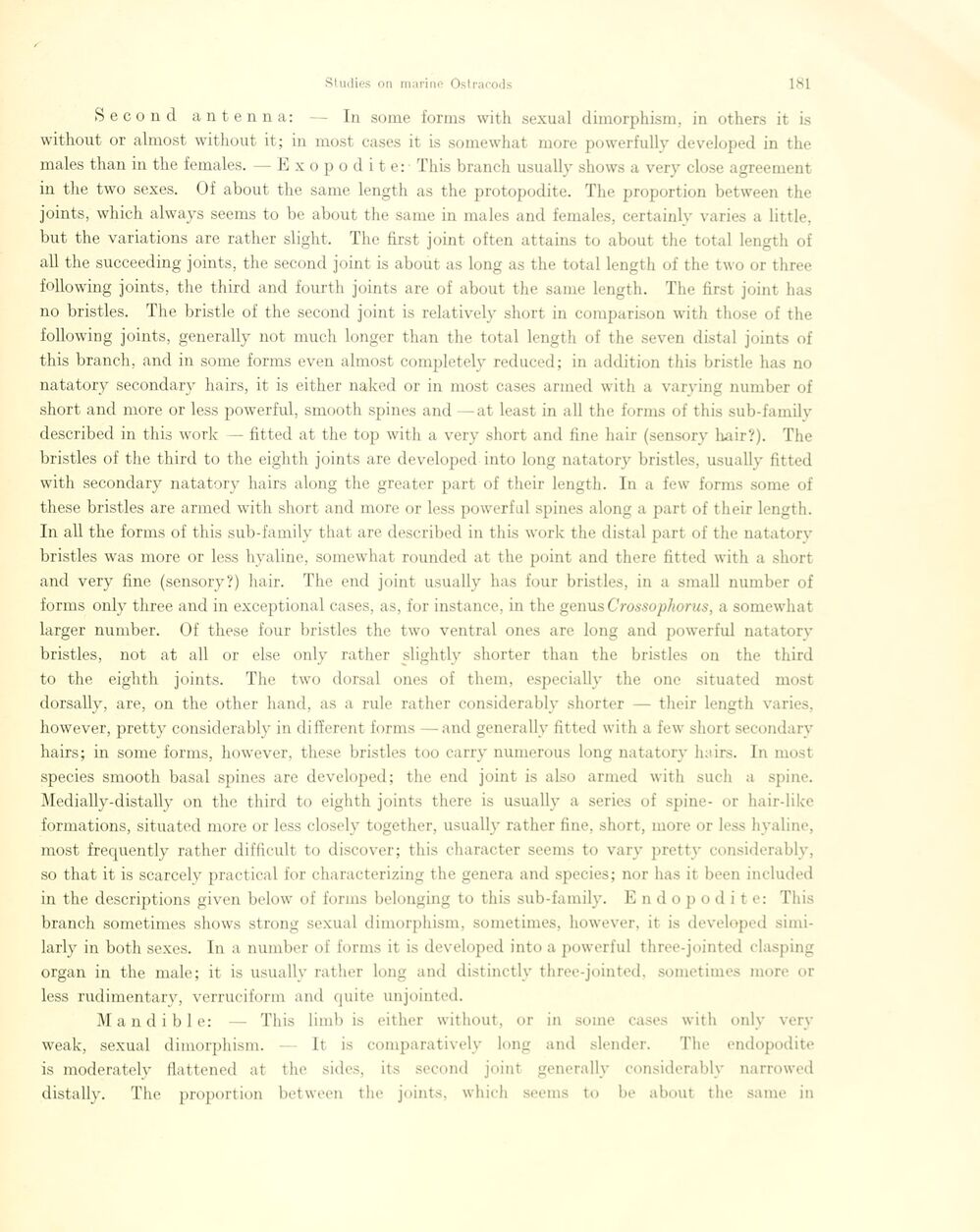
Full resolution (JPEG) - On this page / på denna sida - Sidor ...

<< prev. page << föreg. sida << >> nästa sida >> next page >>
Below is the raw OCR text
from the above scanned image.
Do you see an error? Proofread the page now!
Här nedan syns maskintolkade texten från faksimilbilden ovan.
Ser du något fel? Korrekturläs sidan nu!
This page has never been proofread. / Denna sida har aldrig korrekturlästs.
Second antenna: — In some forms with sexual dimorphism, in others it is
without or almost without it; in most cases it is somewhat more powerfully developed in the
males than in the females. — Exopodite: This brandi usually shows a very close agreement
in the two sexes. Of about the saine length as the protopodite. The proportion between the
joints, which always seems to be about the saine in males and females, certainly varies a little,
but the variations are rather sliglit. The first joint often attains to about the total length of
ail the succeeding joints, the second joint is about as long as the total length of the two or three
following joints, the third and fourtli joints are of about the same length. The first joint lias
no bristles. The bristle of the second joint is relatively short in comparison with those of the
following joints, generally not much longer than the total length of the seven distal joints of
this brauch, and in some forms even almost completely reduced; in addition this bristle has no
natatory secondary hairs, it is either naked or in most cases armed with a varving number of
short and more or less powerful, smooth spines and —at least in all the forms of this sub-family
described in this work — fitted at the top with a very short and fine hair (sensory hair?). The
bristles of the third to the eighth joints are developed into long natatory bristles, usually fitted
with secondary natatory hairs along the greater part of their length. In a few forms some of
these bristles are armed with short and more or less powerful spines along a part of their length.
In all the forms of this sub-family that are described in this work the distal part of the natatory
bristles was more or less hyaline, somewhat rounded at the point and there fitted with a short
and very fine (sensory?) hair. The end joint usually has four bristles, in a small number of
forms only three and in exceptional cases, as, for instance, in the genus Crossophorus, a somewhat
larger number. Of these four bristles the two ventral ones are long and powerful natatory
bristles, not at all or else only rather slightly shorter than the bristles on the third
to the eighth joints. The two dorsal ones of them, especially the one situated most
dorsally, are, on the other hand, as a rule rather considerably shorter — their length varies,
however, pretty considerably in different forms —and generally fitted with a few short secondary
hairs; in some forms, however, these bristles too carry numerous long natatory ha irs. In most
species smooth basal spines are developed; the end joint is also armed with such a spine.
Medially-distally on the third to eighth joints there is usually a series of spine- or hair-like
formations, situated more or less closely together, usually rather fine, short, more or less hyaline,
most frequently rather difficult to discover; this character seems to varv pretty considerably,
so tliat it is scarcely practical for characterizing the genera and species; nor has it been included
in the descriptions given below of forms belonging to this sub-family. En dopo dite: This
branch sometimes shows strong sexual dimorphism, sometimes, however, it is developed
simi-larly in both sexes. In a number of forms it is developed into a powerful three-jointed elasping
organ in the male; it is usually rather long and distinctlv three-jointed, sometimes more or
less rudimentary, verruciform and quite unjointed.
Mandi bl e: This limb is either without, or in some cases with only very
weak, sexual dimorphism. It is comparatively long and slender. The endopodite
is moderately flattened at the sides, its second joint generally considerably narrowed
distally. The proportion between the joints, which seems t<> be about the same in
<< prev. page << föreg. sida << >> nästa sida >> next page >>